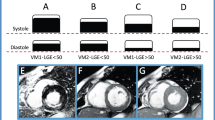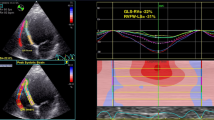Abstract
Prognostic implication of right ventricular dysfunction and infarction scar in the chronic phase of the myocardial infarction has been little analyzed. In 299 consecutive patients (age 63 ± 11 years) with >3 months old myocardial infarction, we quantified right and left ventricular volumes and ejection fractions by cine cardiac magnetic resonance, and right and left ventricular scar tissue by late gadolinium enhancement. During follow-up (median, 2.4 years) cardiac events (cardiac-related deaths or appropriate intra-cardiac defibrillator shocks) occurred in 21 patients. Right ventricular systolic dysfunction (ejection fraction lower the reference mean values—2 SD) was present in 67 patients (22 %), right ventricular late gadolinium enhancement was observed in 15 patients (5 %). After adjustment for left ventricular end-diastolic volume, wall motion score index, and global extent of late gadolinium enhancement, right ventricular dysfunction was an independent and incremental predictor of cardiac events (p = 0.0053), while right ventricular scar tissue extent was not. Right ventricular dysfunction is an independent and incremental predictor of cardiac events also in the chronic phase of the myocardial infarction. In these patients, right ventricular dysfunction does not necessarily mean right ventricular infarction scar, but likely reflects the effects of hemodynamic and biohumoral factors.



Similar content being viewed by others
References
Kinch JW, Ryan TJ (1994) Right ventricular infarction. New Engl J Med 330:1211–1217
Zehender M, Kasper W, Kauder E, Geibel A, Schönthaler M, Olschewski M, Just H et al (1993) Right ventricular infarction as an independent predictor of prognosis after acute inferior myocardial infarction. New Engl J Med 328:981–988
Foussas SG, Zairis MN, Tsiaousis GZ, Theodossis-Georgilas A, Prekates AA, Kontos CF et al (2010) The impact of right ventricular involvement on the postdischarge long-term mortality in patients with acute inferior ST-segment elevation myocardial infarction. Angiology 61:179–183
Shah PK, Maddahi J, Staniloff HM, Ellrodt AG, Pichler M, Swan HJ, Berman DS et al (1986) Variable spectrum and prognostic implications of left and right ventricular ejection fractions in patients with and without clinical heart failure after acute myocardial infarction. Am J Cardiol 58:387–393
Mehta SR, Eikelboom JW, Natarajan MK, Diaz R, Yi C, Gibbons RJ et al (2001) Impact of right ventricular involvement on mortality and morbidity in patients with inferior myocardial infarction. J Am Coll Cardiol 37:37–43
Zornoff LA, Skali H, Pfeffer MA, St John Sutton M, Rouleau JL, Lamas GA, SAVE Investigators et al (2002) Right ventricular dysfunction and risk of heart failure and mortality after myocardial infarction. J Am Coll Cardiol 39:1450–1455
Hamon M, Agostini D, Le Page O, Riddell JW, Hamon M (2008) Prognostic impact of right ventricular involvement in patients with acute myocardial infarction: meta-analysis. Crit Care Med 36:2023–2033
Antoni ML, Scherptong RW, Atary JZ, Boersma E, Holman ER, van der Wall EE et al (2010) Prognostic value of right ventricular function in patients after acute myocardial infarction treated with primary percutaneous coronary intervention. Circ Cardiovasc Imaging 3:264–271
Miszalski-Jamka T, Klimeczek P, Tomala M, Krupiński M, Zawadowski G, Noelting J et al (2010) Extent of RV dysfunction and myocardial infarction assessed by CMR are independent outcome predictors early after STEMI treated with primary angioplasty. JACC Cardiovasc Imaging 3:1237–1246
Grothoff M, Elpert C, Hoffmann J, Zachrau J, Lehmkuhl L, de Waha S et al (2012) Right ventricular injury in ST-elevation myocardial infarction: risk stratification by visualization of wall motion, edema, and delayed-enhancement cardiac magnetic resonance. Circ Cardiovasc Imaging 5:60–68
Hsu SYl, Chang SH, Liu CJ, Lin JF, Ko YL, Cheng ST et al (2013) Correlates of impaired global right ventricular function in patients with a reperfused acute myocardial infarction and without right ventricular infarction. J Investig Med 61:715–721
Ramzy IS, O’Sullivan CA, Lam YY, Dancy M, Tei C, Henein MY (2009) Right ventricular stunning in inferior myocardial infarction. Int J Cardiol 136:294–299
Berger PB, Ruocco NA Jr, Ryan TJ, Jacobs AK, Zaret BL, Wackers FJ et al (1993) Frequency and significance of right ventricular dysfunction during inferior wall left ventricular myocardial infarction treated with thrombolytic therapy (results from the thrombolysis in myocardial infarction [TIMI] II trial). The TIMI Research Group. Am J Cardiol 71:1148–1152
Larose E, Ganz P, Reynolds HG, Dorbala S, Di Carli MF, Brown KA et al (2007) Right ventricular dysfunction assessed by cardiovascular magnetic resonance imaging predicts poor prognosis late after myocardial infarction. J Am Coll Cardiol 49:855–862
Di Bella G, Siciliano V, Aquaro GD, Molinaro S, Lombardi M, Carerj S et al (2013) Scar extent, left ventricular end-diastolic volume, and wall motion abnormalities identify high-risk patients with previous myocardial infarction: a multiparametric approach for prognostic stratification. Eur Heart J 34:104–111
Cerqueira MD, Weissman NJ, Dilsizian V, Jacobs AK, Kaul S, Laskey WK, American Heart Association Writing Group on Myocardial Segmentation and Registration for Cardiac Imaging et al (2002) Standardized myocardial segmentation and nomenclature for tomographic imaging of the heart. A statement for healthcare professionals from the Cardiac Imaging Committee of the Council on Clinical Cardiology of the American Heart Association. Circulation 105:539–542
Hees PS, Fleg JL, Lakatta EG, Shapiro EP (2002) Left ventricular remodeling with age in normal men versus women: novel insights using three-dimensional magnetic resonance imaging. Am J Cardiol 90:1231–1236
Wolk MJ, Bailey SR, Doherty JU, Douglas PS, Hendel RC, Kramer CM et al (2014) ACCF/AHA/ASE/ASNC/HFSA/HRS/SCAI/SCCT/SCMR/STS 2013 multimodality appropriate use criteria for the detection and risk assessment of stable ischemic heart disease: a report of the American College of Cardiology Foundation Appropriate Use Criteria Task Force, American Heart Association, American Society of Echocardiography, American Society of Nuclear Cardiology, Heart Failure Society of America, Heart Rhythm Society, Society for Cardiovascular Angiography and Interventions, Society of Cardiovascular Computed Tomography, Society for Cardiovascular Magnetic Resonance, and Society of Thoracic Surgeons. J Cardiol Fail 20:65–90
Maceira AM, Prasad SK, Khan M, Pennell DJ (2006) Reference right ventricular systolic and diastolic function normalized to age, gender and body surface area from steady-state free precession cardiovascular magnetic resonance. Eur Heart J 27:2879–2888
Positano V, Pingitore A, Giorgetti A, Favilli B, Santarelli MF, Landini L et al (2005) A fast and effective method to assess myocardial necrosis by means of contrast magnetic resonance imaging. J Cardiovasc Magn Reson 7:487–494
Kim RJ, Wu E, Rafael A, Chen EL, Parker MA, Simonetti O et al (2000) The use of contrast-enhanced magnetic resonance imaging to identify reversible myocardial dysfunction. New Engl J Med 343:1445–1453
Kumar A, Abdel-Aty H, Kriedemann I, Schulz-Menger J, Gross CM, Dietz R, Friedrich MG (2006) Contrast-enhanced cardiovascular magnetic resonance imaging of right ventricular infarction. J Am Coll Cardiol 48:1969–1976
Aquaro GD, Pingitore A, Strata E, Di Bella G, Molinaro S, Lombardi M (2010) Cardiac magnetic resonance predicts outcome in patients with premature ventricular complexes of left bundle branch block morphology. J Am Coll Cardiol 56:1235–1243
Van Tassell BW, Bhardwaj HL, Grizzard JD, Kontos MC, Bogaard H, Gomez-Arroyo J et al (2012) Right ventricular systolic dysfunction in patients with reperfused ST-segment elevation acute myocardial infarction. Int J Cardiol 155:314–316
Masci PG, Francone M, Desmet W, Ganame J, Todiere G, Donato R et al (2010) Right ventricular ischemic injury in patients with acute ST-segment elevation myocardial infarction: characterization with cardiovascular magnetic resonance. Circulation 122:1405–1412
Hsu SY, Lin JF, Chang SH (2011) Right ventricular function in patients with different infarction sites after a first acute myocardial infarction. Am J Med Sci 342:474–479
Maughan WL, Sunagawa K, Sagawa K (1987) Ventricular systolic interdependence: volume elastance model in isolated canine hearts. Am J Physiol 253:H1381–H1390
Damiano RJ Jr, La Follette P Jr, Cox JL, Lowe JE, Santamore WP (1991) Significant left ventricular contribution to right ventricular systolic function. Am J Physiol 261:H1514–H1524
Santamore WP, Dell’Italia LJ (1998) Ventricular interdependence: significant left ventricular contributions to right ventricular systolic function. Prog Cardiovasc Dis 40:289–308
Patten RD, Aronovitz MJ, Deras-Mejia L, Pandian NG, Hanak GG, Smith JJ et al (1998) Ventricular remodeling in a mouse model of myocardial infarction. Am J Physiol 274:H1812–H1820
Konishi K, Dohi K, Tanimura M, Sato Y, Watanabe K, Sugiura E et al (2013) Quantifying longitudinal right ventricular dysfunction in patients with old myocardial infarction by using speckle-tracking strain echocardiography. Cardiovasc Ultrasound 11:23
Abbate A, Sinagra G, Bussani R, Hoke NN, Merlo M, Varma A et al (2002) Apoptosis and post-infarction left ventricular remodeling. J Mol Cell Cardiol 34:165–174
Acknowledgments
We are grateful to Claudia Santarlasci for her administrative support.
Conflict of Interest
None declared.
Author information
Authors and Affiliations
Corresponding author
Rights and permissions
About this article
Cite this article
Di Bella, G., Siciliano, V., Aquaro, G.D. et al. Right ventricular dysfunction: an independent and incremental predictor of cardiac deaths late after acute myocardial infarction. Int J Cardiovasc Imaging 31, 379–387 (2015). https://doi.org/10.1007/s10554-014-0559-9
Received:
Accepted:
Published:
Issue Date:
DOI: https://doi.org/10.1007/s10554-014-0559-9




